What is Oshima Tsumugi|The depth of Oshima Tsumugi, Japan's proud textile
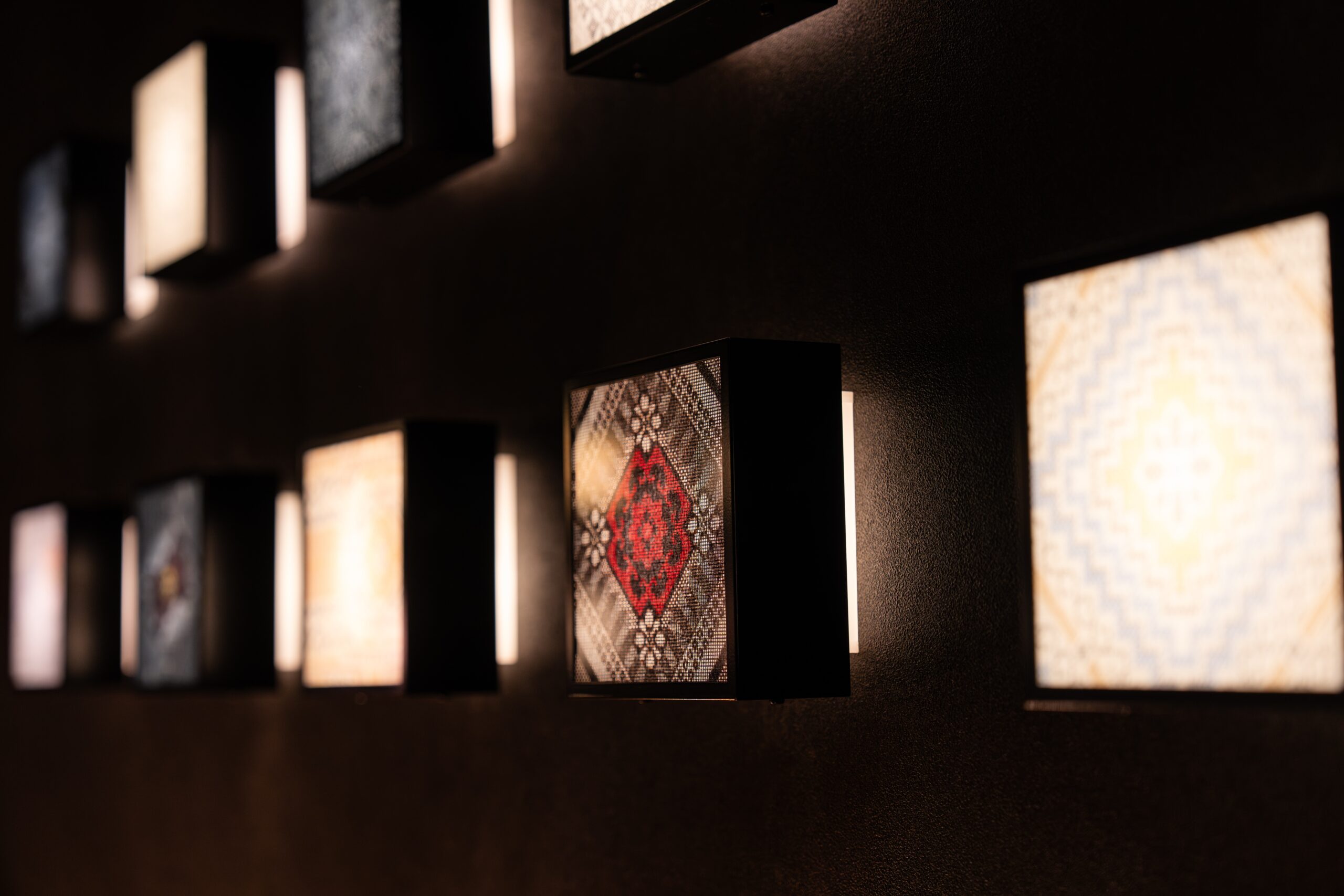
Introduction.
Oshima Tsumugi (Oshima Tsumugi)is a traditional Japanese silk fabric produced mainly on Amami Oshima Island in Kagoshima Prefecture. Its unique texture and beauty have earned it a high reputation among kimono enthusiasts and traditional craft collectors. This article details the history, production process, characteristics, and cultural significance of Oshima silk, as well as its coexistence with modern technology and products.
Article
History of Oshima Tsumugi
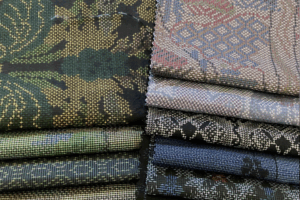
Origin and Development
Oshima tsumugi (Oshima silk) is a type of pongee,Amami Oshima Island, Kagoshima PrefectureIt is a traditional Japanese silk fabric that has been produced mainly in the United States, Europe, and Japan. Its origins are very old, dating back to around the 16th century. Initially woven with plant fibers such as hemp and basho cloth, sericulture began around the 17th century, leading to the development of silk fabrics. The climate of Amami Oshima, blessed with rich nature and a mild climate, has nurtured the uniqueness of Oshima silk.
From the Edo Period to the Meiji Period
During the Edo period, it was recognized as a specialty of the Satsuma clan, and production expanded under the clan's protection. It came to be widely used from the daily wear of the common people to the costumes of the warrior class, and its quality and beauty came to attract attention. In the Meiji period (1868-1912), Western dyeing techniques and weaving machines were introduced, further improving the quality. Oshima tsumugi gained nationwide fame and became known both in Japan and abroad.
Modernization and Inheritance of Tradition
In the 20th century,Oshima tsumugi has established itself as a luxury silk fabric.In 1955, it was designated an Important Intangible Cultural Asset of Japan. Today, Amami Oshima and other regions continue to develop products that suit modern lifestyles while inheriting traditional techniques.
Manufacturing Process of Oshima Tsumugi
Raw material preparation
The production of Oshima tsumugi begins with the selection of high quality silk threads. The cocoons used as raw material are mainly produced in Japan.
Dyeing process

- Mud dyeing:
- To produce the unique black color, rice field mud is used for dyeing.
- This process produces the unique luster and deep coloring of tsumugi silk.
- Kasuri kasuri:
- For dye-proofing, bundle the threads and tie the area to be patterned with thread or cloth.
- Dyed with vegetable dyes:
- Dyeing is done using plant dyes such as indigo, camellia, and sharinbai.
- The natural pigments produce gentle and deep colors.
Weaving Process
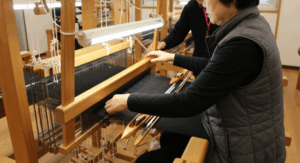
- Seikei:
- Before weaving, the warp threads are arranged to a certain length and number.
- Weaving:
- The weaving is done carefully using a traditional high loom (takabata).
- Skilled craftsmanship produces intricate patterns and beautiful textures.
- Finishing:
- The woven fabric is washed, dried, and ironed to finish.
Characteristics of Oshima Tsumugi

Unique texture and luster
Oshima silk is,Mud Dyeing and Vegetable DyesIt has a unique deep hue and elegant luster due to the use of The more it is worn, the more lustrous it becomes, and it does not fade easily even after many years of use.
Intricate patterns and patterns
By the kasuri technique,geometrical patternThe delicate patterns are based on motifs of nature and the environment. In particular, the "toppage tsumugi," in which the same pattern appears on both sides, is known as a demonstration of Oshima tsumugi's advanced techniques.
Lightweight and heat retention
The use of fine yarns and loose weave makes it extremely lightweight and comfortable to wear. It also has excellent heat retention properties because it contains a lot of air.
durability
High quality silk threads and careful manufacturing process,Very strong and long-lasting textileThe result is that it is a With proper care, it can be passed down for generations.
Cultural Significance of Oshima Tsumugi
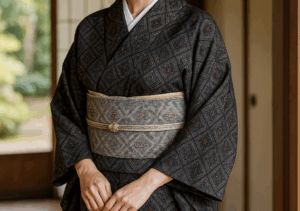
Value as a traditional Japanese craft
Oshima tsumugi is one of the traditional crafts that symbolize Japanese textile culture and has been handed down for more than 1,000 years.important intangible cultural assetIn 1976, it was certified by the Minister of Economy, Trade and Industry as a traditional craft.
There are more than 30 manufacturing processes, most of which are done by hand by craftsmen. The fruits of these techniques are not merely clothing, but are part of our world-class cultural heritage as "cloth art" that embodies the Japanese sense of nature, spirituality, and aesthetics.
Contribution to the local economy
Oshima tsumugi has long supported the local economy as one of the core industries of Amami Oshima Island and its surrounding areas in Kagoshima Prefecture. The production of Oshima tsumugi cannot be completed by a single craftsman alone, but is made up of closely interlocking processes based on the division of labor. Therefore, it has become a place of employment for many people in the region and a local industry.An entity that supports the foundation of the local communityIt is.
The island is also attracting attention as a tourism resource, and through studio tours and hands-on programs, the attraction of Amami Oshima is being communicated to tourists from Japan and abroad. These efforts not only pass on traditional techniques, but also lead to the establishment of local brands and the revitalization of the local economy.
Inheritance of Kimono Culture
Oshima tsumugi, with its delicate patterns and elegant luster, has been loved by many people as a representative of Japanese kimono culture. In particular,Geometric kasuri patterns and patterns with plant and nature motifsis not only visually beautiful, but also contains deep meaning and prayer, subtly reflecting the wearer's individuality and way of life.
Today, kimono is being proposed not only for ceremonial occasions such as weddings, funerals, and coming-of-age ceremonies, but also as a "casual pongee" that can be enjoyed in everyday life and as a modern Japanese style of dress.
Issues of Oshima Tsumugi in the Modern Age
Decrease in demand
Demand for Oshima tsumugi has been declining year by year due to the growing trend away from kimonos and changing lifestyles. This has also led to a decrease in the number of manufacturers and craftsmen, affecting the survival of the industry.
lack of successors
The production of Oshima tsumugi requires advanced technology,Years of experience and trainingare needed. However, the number of younger generations of craftsmen is decreasing, and passing on skills has become an issue.
Securing raw materials
It is becoming increasingly difficult to secure high quality silk yarns and natural dyes. In particular, the decline of the domestic sericulture industry has affected the procurement of raw materials.
Price hikes
Due to higher production costs and lower demand,Price of Oshima silk soarsThis has made them even more inaccessible to the average consumer. This makes them even more inaccessible to the average consumer.
Oshima Tsumugi & Japanese Modern Design|New Traditions for Everyday Livingcraft

Oshima tsumugi is a traditional Japanese craft with hundreds of years of history, yet it has a beauty that harmonizes with modern sensibilities. We are located in Kita Maruyama, Sapporo.Japanese Modern N6 Kita MaruyamaWe offer many items that are modern reinterpretations of Oshima tsumugi, and we also have a "Oshima Tsumugi" line of products.Oshima Tsumugi Teddy Bearand glass crafts," which fused with theCrystal OshimaWe propose new forms of traditional crafts that can be enjoyed in daily life, such as
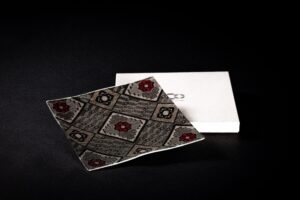
These modern Japanese design products add dignity and warmth to a space, and at the same time, they are a reminder of Japanese culture in everyday life. The deep beauty of Oshima tsumugi quietly accompanies modern life and brings richness to the user's heart. The "Japanese Modern N6 Kita Maruyama" is,Store store store where tradition and innovation intersect.The company continues to transmit new possibilities of craftsmanship as
If you are interested, please visit our store in Sapporo. You can visit our shop without an appointment, but we recommend you to make an appointment to ensure your visit.
summary
Oshima tsumugi is one of the most beautiful and technically advanced traditional Japanese textiles. Its history is deeply connected with Japanese culture and has fascinated people throughout the ages. However, it faces various challenges such as changing demands in modern society and a lack of successors.
A multifaceted approach is being attempted to address these issues through the development of new applications, technological innovation, and expansion into international markets. Efforts continue to be made to meet modern needs while preserving the traditions of Oshima tsumugi.
Oshima tsumugi is not just a textile,Crystallization of Japanese aesthetics and technologyIt is. It is an important role for us modern people to understand its value and pass it on to the next generation. By rediscovering the charm of Oshima tsumugi and incorporating it into our daily lives, we can contribute to the inheritance of traditional Japanese culture.

